This article explores the importance of forests in Japan, discussing how urban areas still manage to safeguard natural areas and the government initiatives in place to protect them. It also highlights quasi-national forests, the five wilderness areas of Japan, and the role of temples and shrines in forest preservation. Finally, it emphasizes the need to take a proactive approach to environmental preservation in order to balance the country's densely populated urban population with the need to sustain natural areas.
Japan is home to some of the most beautiful forests in the world, boasting a variety of different species of trees and plants. From the cedar-filled forests of Hokkaido to the ancient cypress and cryptomeria trees in the Yamato Mountains, Japan's diverse forests are a sight to behold. These lush forests provide Japan with a wealth of natural resources and habitat for many species of animals and plants. In addition, they are also an important part of the country's culture, providing locals with a place for spiritual contemplation, relaxation, and recreation.
In Europe, a quasi-national forest is defined as a forest area that has been designated by the government for protection and conservation. These areas are typically large and undeveloped and are managed by national forestry services. In Japan, quasi-national forests are defined in much the same way as they are in Europe. However, they also encompass shrines 🏯 and temples 🛕 that are owned and managed by religious organizations, as well as areas of urban green spaces. This distinction is important, as it highlights the importance of both natural and man-made areas in Japan's forest conservation efforts.
A Few Other Countries with Quasi-National Forests:

Located off the coast of Kyushu, Yakushima is a UNESCO World Heritage Site and is home to some of Japan’s oldest and most impressive forests. It is known for its lush vegetation, including ancient cedar trees, and for its diverse wildlife, including macaques, sea turtles, and a variety of birds. It is also home to a number of rare species, such as the Yakushima macaque and the Yakuzaru giant flying squirrel.
The most urban quasi-national park in Japan is the Shinjuku Gyoen National Garden. Located in Tokyo,

this park was originally established by the Meiji government in the late 19th century. It is home to a variety of trees and plants, including cherry blossom trees, as well as a number of ponds, lakes, and gardens. The park is a popular destination for locals and tourists alike, providing a tranquil escape from the hustle and bustle of the city.
Look forward to learning more about the national parks in future posts, but for now, here's a list all Quasi-National Parks in Japan:
Japan's Quasi-National Forests often share land with temples and residential homes. These forests typically have boundaries that exist between public and private lands, allowing the public to access the forests while also protecting the privacy of residents and temples. There are also regulations in place to protect the forests, such as restrictions on hunting and the cutting of trees.

In Japan, urban areas are densely populated but still manage to maintain natural areas. Various initiatives have been implemented to protect forests and other natural spaces, such as the METI's green growth strategy. Also of note, the "Green Up Japan" campaign encourages citizens to plant trees in their local area, taking small steps towards preserving the environment while still living in a densely populated urban setting. In addition, many cities have implemented reforestation projects, aiming to restore damaged forest areas and promote biodiversity. By taking a proactive approach to environmental preservation, Japan is able to balance its dense urban population with the need to preserve natural areas.
In Japan, forests are also closely associated with religious sites, particularly temples and shrines. Many of these sites are located in forests, and the temples and shrines help protect the forests from being over-exploited. In some cases, the temples and shrines are even directly involved in forest preservation. For example, some temples have implemented programs to promote reforestation and the conservation of natural resources. As such, the role of temples and shrines in forest preservation is essential to preserving the beauty of Japan's forests.
In addition to the quasi-national wildernesses highlighted in the list above, the Japanese government has designated one other park as a wilderness area. The Chubu-Sangaku National Park in Nagano. The park is unique because it contains some of the most spectacular scenery in Japan. The park is home to some of the highest mountain peaks in the country, including the iconic Mount Yari and Mount Hotaka. The park also contains a variety of alpine vegetation, including rare plant species, and is home to a number of endangered animal species.
What is the Aokigahara, and how does it interact with people from the city?
The Aokigahara is a forest located at the base of Mount Fuji in Japan. It is known as the "Sea of Trees" because of its dense forest cover. The Aokigahara is an important part of Japan's culture and has a long history of being associated with death, suicide, and the supernatural. The forest is a popular destination for people seeking solace or who are contemplating suicide.
The forest is also a popular destination for city dwellers looking for a place to escape the hustle and bustle of the city. The Aokigahara provides a peaceful and tranquil environment for those seeking a break from their busy lives. The forest provides a place for people to connect with nature, as well as a place for reflection and contemplation. The forest also serves as a reminder of the fragility of life and a reminder to appreciate all that is around us.
The Aokigahara is also home to a variety of wildlife. The forest is home to species such as Japanese macaques, Japanese serow, Japanese marten, and Japanese badgers. Additionally, the forest is home to a variety of rare and endangered plant species, including Japanese white pine and Japanese red pine.
So you see, the so-called "suicide forest" is not as bad as it has been made out to be, and provides people, including urban dwellers an escape from the pace and intensity of urban life.
The most famous bamboo forest near a major Japanese city is the Sagano Bamboo Forest in Arashiyama, Kyoto. This forest is an iconic tourist attraction, boasting an impressive display of towering bamboo groves that stretch for several kilometers. The forest is especially beautiful in the morning when the sun casts a golden light over the bamboo stalks. It is also popular with photographers seeking to capture the beauty of the forest. Additionally, the forest is home to a variety of wildlife, including monkeys and birds. The forest's tranquility and beauty make it a popular destination for visitors to Kyoto and a great way to escape the hustle and bustle of the city.
Forests in Japan are increasingly being recognized for their role in promoting the psychological health of society. Studies have suggested that spending time in nature can reduce stress levels and bring about a sense of calm and relaxation. Additionally, forests in Japan provide a unique opportunity to take part in activities such as hiking, bird watching and biking, which can help to boost mental health. By providing the opportunity for people to connect with nature, forests in Japan are helping to create a healthier society both mentally and physically.
As Japan continues to strive for sustainability and the preservation of their natural resources, forests in Japan have become an important part of the culture. Not only are they a source of timber, but they have also inspired the preservation of traditional craft and the development of innovative new crafts that are gentle to the earth. By utilizing natural materials such as bamboo, wood, and plants, these crafts not only conserve the beauty of nature but also take into consideration the environment. These new crafts have become a symbol for sustainability and conservation in Japan.
For sustainable places to buy forest-sourced items, check out these Japanese small businesses.